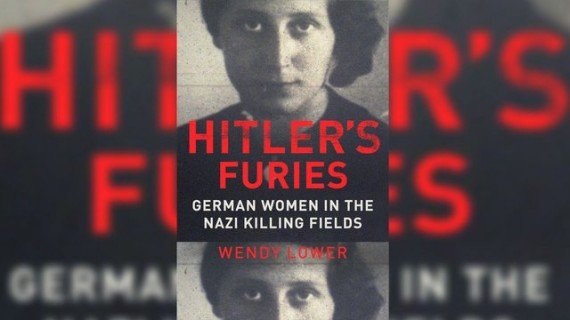Women Were Nazis, Too
Wendy Lower documents the half-million women who helped Hitler carry out the Holocaust.
A new book documents the women who helped Hitler carry out the Holocaust.
In “Hitler’s Furies: German Women in the Nazi Killing Fields,” a nonfiction long-list contender for the 2013 National Book Award, Lower profiles 13 women who became Nazi killers and accomplices, and contends that these women are representative of hundreds of thousands of ordinary German women who “got away with murder.”
According to Lower, a professor at Claremont McKenna College, the half-million women who participated in the mass murders that took place during the years 1941-44 in the killing fields of the Nazi East — the occupied areas of present-day Poland, Belarus, Ukraine, Lithuania, Latvia and Estonia — have been largely ignored by historians and the criminal justice system. Pieced together by Lower from survivor interviews and archival documents that became accessible for scholarly review only after the fall of the Iron Curtain, the accounts of these women in their roles as nurses, teachers, secretaries and SS wives illustrate how they participated in genocidal violence.
But why would so many Nazi criminals be overlooked until now, 70 years later? Lower describes a German postwar consciousness of closely guarded secrets, where evidence of wrongdoing was entombed as much in the repressed memories of the living as in the passing of the dead. Embedded in this culture of forgetting were abiding assumptions about the nature of womanhood and their role in society. These assumptions functioned as an interpretive bias, fostering perceptions of German women as mostly innocent hausfraus tending to hearth and home, while attributing more notorious acts of terror and sadism to female camp guards who were viewed as deviant, marginal perpetrators.
Lower’s book explores and challenges this gender bias, depicting Nazi women as immersed in the blood-soaked landscape of the “wild east,” where Jews and forced laborers were shot routinely in broad daylight, and where the foul odor of mass graves was the air they breathed. “Interaction with Jews and mass murder entered into these women’s everyday lives in unexpected but recurring ways,” Lower writes, describing the situation of young nurses who delivered lethal injections and of secretaries who typed up death orders.
The most chilling accounts in “Hitler’s Furies” are about the women whose violence was targeted at children. In unsparing detail, Lower recounts the viciousness of Johanna Altvater, a young secretary who threw one child after another to their deaths off a third-floor railing in a Jewish ghetto. Or Erna Petri, wife of an SS officer, who in a gruesome version of Hansel and Gretel fed six tattered Jewish children in her home before marching them to the pit of a nearby mass grave and shooting them one by one, execution-style.
If, as Lower argues, these were not sociopaths but ordinary women who didn’t exhibit violent tendencies either before or after the war, how do we make sense of their appalling participation in Nazi genocide? What do these women tell us about history, gender, what it is to be human?
That those who carried out the Holocaust were mostly ordinary people who were just going about their daily lives has been established for at least half a century; Hannah Arrendt famously laid out the case in Eichmann in Jerusalem: A Report on the Banality of Evil way back in 1963. More recently, Daniel Goldhagen’s Hitler’s Willing Executioners: Ordinary Germans and the Holocaust drew attention to the sheer scope of the involvement of the citizenry. It stands to reason, then, that a lot of German women took part.
My late wife and I toured the Anne Frank House on our 2006 visit to Amsterdam. What stood out to her was the degree to which the concentration camps documented their actions, logging in by name and in as much detail as possible those brought into the camps and those who were slaughtered. Because of my professional training, I wasn’t the least bit surprised by that: they thought of themselves as dutiful bureaucrats doing their job and needed to maintain records.
The twist in Lower’s book is that, despite the intensity of study of the topic over the ensuing seven decades, we still think of the evil-doers almost exclusively male.
Raised on the Nazi ideal of female wholesomeness, where the rosy glow of a woman’s cheeks was to come not from makeup but from robust activity, and where her worth increased with every child she bore, women nonetheless became killers once they landed on the eastern front. And this documented violence, challenging as it may be to 21st century gender expectations, if widely known at the time would have threatened Nazi gender ideology, exposing the falseness of Hitler’s Aryan mythology and humiliating the women of the Reich.
But isn’t this whiff of women’s presumed moral purity still in the air today? So often women are held, in comparison with men, as the kinder sex, more peace-loving and relational, more committed to the protection of life. Yet the evil of the Holocaust was clearly an equal-opportunity affair, entered into by women who birthed children and loved their husbands as well as by the men who loved them in return.
But, of course, the same was true of the men. The man who designed and ran Auschwitz was a beloved husband and father who doted on his kids.






If you haven’t seen the movie or read the book I would recommend The Boy in the Striped Pyjamas. I believe it’s available on Netflix streaming but it’s probably not suitable for small children.
People have always been able to isolate bad behaviors towards those whom they consider to be the “other”. One could be a pillar of the community in every way possible, but still abuse one’s slaves, or the illegal immigrants one employs. I suspect most of us have grandparents or great-grandparents who loathed one ethnic group or another. Hence, I dont really find it surprising that women were also killers. I am surprised at the extent. I had always assumed that there were few women killers mentioned since they were not placed in positions of authority and simply didnt have the means to kill very many.
Steve
@steve: So true! I remember my dear sweet late mother who thought it was the end of times when Obama was elected in 2008 – she was 86. What’s odd about her prejudice is she grew up in Idaho and Eastern Washington and I doubt she even saw more than a handful of people of color until she moved to Portland when she was 18. She used to rant about how hispanics should be forced to learn English although her own grandmother who came from Sweden when she was 20 refused to learn English.
You can add to that list the assumption that all women want children, or that after you give birth you’ll immediately love your baby.
The more insidious effect of the “all women are naturally caring” myth is because of that, “caring activities” are not considered to be worth paying for–they can always be dumped off on some woman. Which is why activities such as nursing of the elderly and daycare is so badly paid.
Of course there were Nazi women who committed atrocities. Until quite recently, though, historians and academics ignored women as standard procedure.
The lessons of Eichmann in Jerusalem, and the “banality of evil” are also routinely ignored. Americans are so acculturated to make villains into caricatures of eeeevil, even though the potential for evil is uncomfortably normal.
Recommend Philip Zimbardo’s The Lucifer Effect on this one.
@Grumpy Realist: People are amazed that I was the caregiver for my mother in her final years. They can’t imagine that a son much less a man would change his mother’s Depends or give her a bath for over a year.
The irony is that NAZI ideology and policy promoted women as serving the Reich primarily as breeders. To lower unemployment for men, women were paid to stay at home and paid more by having children. And its hard not to see that by and large this was a broadly popular policy that gave stability (and jobs) in the inter-war period. By the time of the war, women were needed. I’m guessing the book details women that while supportive of most aspects of NAZI ideology were liberated and sought opportunities to show their worth outside of the home.
Not my ex. The ways she used and abused her relations with my sons are chilling. They have come face to face with this fact repeatedly, yet a “mother’s love” conquers all, even the truth.
@Ron Beasley:
You’re a mensch.
Grumpy Realist: You can add to that list the assumption that all women want children, or that after you give birth you’ll immediately love your baby.
THIS!!!
When the other women in my office bring their children around or show off the newest pics, they are blatantly shocked when i don’t drop everything and start cooing like the rest of them. When I finally put my foot down and banned bringing children into our section, I was treated like a monster. I pointed out we are there to work and bringing in the child just to show them off (like a toy!!) is counterproductive and insulting to the child to boot – they should be in school, not being showed off like a trophy.
I fence. The men I fence with are amazed at the aggressiveness I and the other girl in the club display. We are known to be the boldest of the group – strike first and all that to make up for lack of height/reach/strength. At a minor tournament, my opponent wouldn’t shake hands after my victory and muttered that it was a shame to loose to someone so unfeminine as myself. He’d expected an easy win, you see, and hadn’t tried very hard. Women aren’t supposed to be fierce or a threat. Stupid – in nature, we’re the biggest threat!!
The idea that women wouldn’t be Nazis is so stupid on its face, yet so pervasive. Sympathies for an ideology know no gender nor age. I fully expect that many women got away with horrid crimes and took advantage of the menfolk’s “pity and understanding” to walk scot free. Used the stereotype to their advantage and quietly passed along the same ugly thoughts and beliefs to the next generation. The poison pill within.
KM? Killer Mantis?
Steve
I remember reading about her in The Third Reich At War
@DC Loser: Excellent article at that link.
steve: KM? Killer Mantis?
Hmm, no. But I’ll take it into consideration. My new sabre doesn’t have a name yet…. 🙂 My favorite foil is named the Lost Lenore – it tends to give the menfolk pause (and the women in the club a smile).